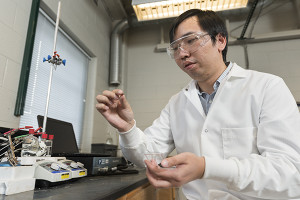Neil deGrasse Tyson once said, “Space exploration is a force of nature unto itself that no other force in society can rival.” Unfortunately, there are many factors that stifle human space exploration – one of which is the lack of oxygen.
How people will breathe is a constant concern among space missions. It’s impossible to shuttle oxygen tanks out and the air recycling systems are only about 50 percent efficient when it comes to recovering oxygen from carbon dioxide – but now a new development could mean easy breathing in space.
Research on a discovery from January 2014 is being expanded to develop silver electrocatalysts that may help enable long-term space travel. The original paper, “A selective and efficient electrocatalyst for carbon dioxide reduction,” detailed a development from scientists at the University of Delaware of a silver electrocatalyst that, due to its nanoscale structure, could convert carbon dioxide to carbon monoxide with 92 percent efficiency – freeing the oxygen in the process.
Upon seeing this study, scientists Ken Burke of the NASA Glenn Research Center contacted the lead author of the paper, Feng Jiao.
This from University of Delaware:
Burke’s lab was working on a technology to convert two molecules of carbon monoxide to one molecule of carbon dioxide and one molecule of carbon. If they can combine their systems, says Jiao, “then eventually we can completely split CO2 to one molecule of carbon and one molecule of oxygen.”
Together, the new process has the potential to recover 100 percent of oxygen from carbon dioxide.
Looking for more research on electrocatalysts? Check out the most recent papers on the topic in our Digital Library!


